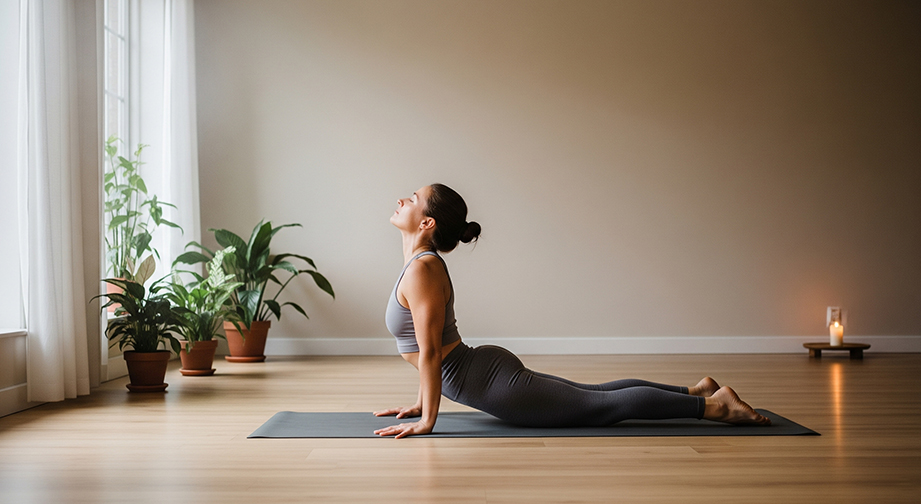Bhujangasana (Cobra Pose): Step-by-Step Yoga Guide for Beginners
Introduction
Bhujangasana, pronounced as bhu-jang-AA-sa-na, is a foundational yoga posture also called the Cobra Pose. In Sanskrit, "bhujanga" means cobra or serpent, and "asana" means posture. This energizing asana gently awakens your spine, opens the chest, and boosts both strength and flexibility.
Essence of Cobra Pose: Revitalizing and Opening
If you've ever felt stiff after sitting too long at work or waking up with an achy back, Bhujangasana is your friendly antidote. This beginner-friendly pose counteracts slouching, relieves tightness, and leaves you feeling refreshed.
Step-by-Step Guide to Bhujangasana (Cobra Pose)

- Start on your belly. Lie face down with your legs stretched back, tops of feet pressing into the mat. Place your palms flat on the mat under your shoulders. Elbows should be close to your ribcage, pointing backwards.
- Set your legs and hips. Bring your legs together or hip-width apart. Press the fronts of your thighs and pubic bone gently into the ground.
- Inhale and lift. As you inhale, slowly press into your palms and begin to lift your head, chest, and upper belly off the mat. Keep your elbows slightly bent and hugged in toward your sides.
- Open the chest. Gently roll your shoulders back and down, broadening your collarbones. Keep your neck long and gaze forward or slightly up—don't crunch the neck.
- Breathe and hold. Continue to inhale as you lengthen the spine and exhale as you soften your shoulders. Hold for 3–5 slow breaths (about 15–30 seconds). Come down on an exhale.
- Duration / Rounds: Hold for 3–5 breaths. Repeat 1–3 times, resting between rounds.
- Breathing: Inhale to lift up. Exhale to lower down.
- Modifications for Beginners:
- Keep elbows bent and barely lift the chest for a “baby cobra.”
- Place a folded blanket under your pelvis for padding.
- Intensifications for Advanced Yogis:
- Straighten arms more (without locking elbows) and lift higher, only if your lower back feels comfortable.
- Try raising your hands an inch off the mat—engage only your back, not your arms.
Alignment & Safety Tips
- Key Alignment:
- Distribute lift along the entire back—don’t overarch the lower back.
- Keep elbows drawing toward your ribs, not flaring out.
- Shoulders roll back and down, away from ears.
- Press feet and pubic bone gently into the mat for support.
- Common Mistakes:
- Lifting too high, causing discomfort in the lower back.
- Shoulders hunched up by the ears.
- Locking elbows or forcing the lift with arms only.
- Safety Precautions:
- Avoid if you are pregnant (try Sphinx Pose instead).
- Refrain if you have recent abdominal surgery, back injury, or hernia.
- If you have carpal tunnel, keep wrists happy by lowering intensity or using fists.
Benefits of Bhujangasana (Cobra Pose)
Physical Benefits:
- Strengthens spine, arms, and shoulders
- Improves spinal flexibility and posture
- Opens chest and lungs (aiding deeper breathing)
- Stretches abs, hip flexors, and front of the body
Mental Benefits:
- Reduces fatigue and mild depression
- Relieves stress and tension
- Promotes present-moment mindfulness
Energetic / Chakra Connection:
- Stimulates the Heart Chakra (Anahata) – fostering openness and compassion
- Energizes the Solar Plexus Chakra (Manipura) – boosting confidence and vitality
Contraindications
- Pregnant people (especially after 1st trimester)
- Those with severe back, neck, or wrist injuries
- Recent abdominal surgeries or hernias
- Safe Alternatives: Try Sphinx Pose or Supported Cobra with more props
Beginner’s Tips & Variations
- Use Props:
- Slide a folded blanket or bolster under hips for gentle support.
- Place a block under each hand for “mini” lift (reducing wrist pressure).
- Gentle Variations:
- Practice Baby Cobra (Bhujangasana variation) by lifting only the chest lightly, keeping elbows bent and close to body.
- Advanced Variations:
- Try Upward-Facing Dog (Urdhva Mukha Svanasana) – straighten your arms, lift thighs and knees off the ground.
- Add gentle lateral neck movement or lift feet for an extra challenge (only if comfortable).
How to Include Bhujangasana in a Yoga Flow
- Best as a warm-up or main practice to awaken the back body and energize the mind.
- Pairs well with:
- Downward-Facing Dog (Adho Mukha Svanasana)
- Child’s Pose (Balasana)
- Locust Pose (Salabhasana)
Mind-Body Connection
While practicing Bhujangasana, focus on grounding the pelvis, lengthening your spine, and opening your heart. Tune in to your breath and sensations in your body. This asana invites self-awareness and encourages you to embody qualities of courage and openness—much like the cobra itself.
Chakra significance: Opens the heart (Anahata) and awakens inner energy.
Bhujangasana (Cobra Pose) at a Glance
- Asana Name: Bhujangasana (Sanskrit), Cobra Pose (English)
- Level: Beginner
- Focus Areas: Spine, chest, shoulders, core
- Duration: 15–30 seconds (hold for 3–5 breaths, repeat 1–3 times)
- Best Time to Practice: Morning or anytime you need an energizing stretch
Frequently Asked Questions
Is Bhujangasana safe for everyone?
Bhujangasana is generally safe for most healthy individuals, but avoid if you’re pregnant or have back, wrist, or abdominal injuries. Always listen to your body and consult a doctor if unsure.
How often should I practice Bhujangasana?
Practice Bhujangasana 3–4 times per week or add it to your daily routine for best results. Consistency helps improve flexibility and strengthen your back.
What if my lower back hurts in Bhujangasana?
Lower your chest, keep more weight in your hands, or try a “baby cobra” variation. Never force the lift; stop if you feel pain.
Yoga practice is personal—always move at your own pace. Namaste!